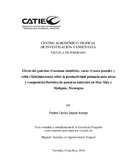| dc.contributor.advisor | Ibrahim, M. | |
| dc.contributor.author | Zapata Arango, Piedad C. | |
| dc.contributor.other | CATIE - Centro Agronómico Tropical de Investigación y Enseñanza | |
| dc.date.accessioned | 2014-10-20T04:46:57Z | |
| dc.date.available | 2014-10-20T04:46:57Z | |
| dc.date.issued | 2010 | es_ES |
| dc.identifier | 374578 | es_ES |
| dc.identifier.uri | https://repositorio.catie.ac.cr/handle/11554/4891 | |
| dc.description | Tesis (Mag.Sc.) - CATIE, Turrialba (Costa Rica), 2010 | es_ES |
| dc.description.abstract | Entre abril y julio de 2009 se evaluó el efecto de árboles de carao (Cassia grandis), roble (Tabebuia rosea) y guácimo (Guazuma ulmifolia) sobre la productividad primaria neta aérea (PPNA) y composición florística de pasturas naturales en Muy Muy y Matiguás, Nicaragua y la relación existente de estas variables con la humedad del suelo, precipitación, composición química del suelo y densidad de copa de las especies arbóreas. Como resultados se encontró que la especie más común en los pastizales fue Paspalum notatum; la riqueza y diversidad de especies herbáceas fue mayor en los meses lluviosos (mayo, junio, julio) con respecto a abril (mes seco) y bajo los árboles (independientemente de la especie arbórea) que en la pastura abierta.Bajo árboles de carao la cobertura de especies herbáceas varió significativamente frente a árboles de roble, guácimo y en la pastura abierta. La variabilidad en la PPNA de las pasturas evaluadas fue explicada en un 26% por la precipitación presentada en estos meses. Se registró una disminución en la PPNA del 15.8% bajo los árboles con respecto a la pastura abierta.
During April to July 2009, I assessed the effect of three trees species, carao (Cassia grandis), roble (Tabebuia rosea) and guácimo (Guazuma ulmifolia) on aboveground net primary productivity (ANPP) and floristic composition of the natural pastureland in silvopastoral systems occurring in the areas of Muy Muy and Matiguás, Nicaragua. I explored the relationship of these variables with the soil humidity, precipitation, soil chemical composition and the density of the tree crown. The most abundant grassland species was Paspalum notatum. Richness and diversity of grassland species grasses were greater in the rainy months (May, June, July) than in April (dry month).Also species richness under the tree (regardless of the species) was higher than in the open grassland. The cover of grass species was significantly lower under carao trees than under trees of roble and guácimo trees, and in the open grassland. | es_ES |
| dc.language.iso | es | es_ES |
| dc.publisher | CATIE, Turrialba (Costa Rica) | es_ES |
| dc.rights | info:eu-repo/semantics/openAccess | es_ES |
| dc.subject | PASPALUM NOTATUM | |
| dc.subject | PASPALUM CONJUGATUM | |
| dc.subject | PASTIZALES | |
| dc.subject | SISTEMAS SILVOPASCICOLAS | |
| dc.subject | COMPOSICIÓN BOTÁNICA | |
| dc.subject | DENSIDAD BIOMASA | |
| dc.subject | PLANTAS HERBACEAS | |
| dc.subject | NICARAGUA | |
| dc.subject.other | Sede Central | |
| dc.title | Efecto del guácimo (Guazuma ulmifolia), carao (Cassia grandis) y roble (Tabebuia rosea) sobre la productividad primaria neta aérea y composición florística de pasturas naturales en Muy Muy y Matiguás, Nicaragua | es_ES |
| dc.type | Tesis de maestría | es_ES |


